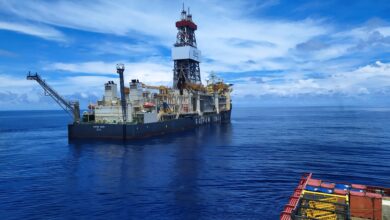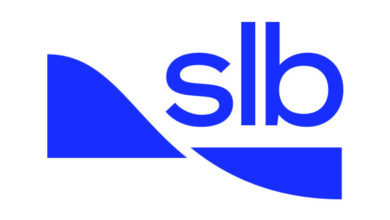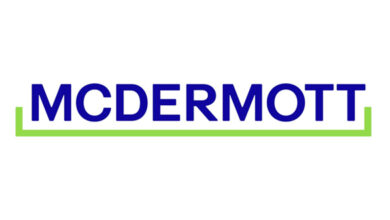Our technologies have moved on; our people must move with them
PTTEP: Full potential of technical innovations won’t be realized unless personnel competency can keep up
By Linda Hsieh, Managing Editor
 Kanit Sangwongwanich is Executive VP of the Operations Support Group for Thailand’s PTT Exploration & Production (PTTEP).
Kanit Sangwongwanich is Executive VP of the Operations Support Group for Thailand’s PTT Exploration & Production (PTTEP).
Looking at the current state of the drilling industry, what are the most relevant and critical challenges we face?
In terms of drilling and completion technology, I think the industry is moving quite well. However, development of people’s capabilities is not keeping pace with technology development. I have the view that we are still doing the same things that we have been doing for the past decades while technology has already moved to a new horizon. We have new drilling equipment and new completion technologies, but the people still need to learn how to apply those technologies effectively. If not, we won’t realize the potential that new technology can deliver in terms of safety and efficiency. We must match the human resources side to the hardware in order to get the most benefit out of technology advances.
For me, the capability of our people and changing the way they work is the most critical challenge. This will require much more preplanning, of course. Because equipment and wells are more complex, we need to have remedial action plans in place so that we are prepared.
In the Gulf of Thailand specifically, we are mostly drilling standard wells. It’s important that we continue to reduce downtime and contain or even lower the well cost while not giving up on safety. We have to balance that quite a bit.
If people’s capability is not keeping pace with technology, does the answer lie in more training?
At PTTEP, we have a lot of young and capable engineers. At the same time, we have experienced personnel who are near retirement – both expatriates and Thai nationals. We’re working very hard to accelerate the time to autonomy for the young engineers by helping them to acquire the necessary skills and then providing a way to certify those skills. This means we need to provide them with a clear roadmap of how to progress in their careers. If they want to become a senior drilling manager or a superintendent, they will know what skills they need to acquire.
I have the view that formal training provides only knowledge, not skills. In order for them to acquire the necessary skills, we need to give them the opportunity to apply their knowledge in the field. At the same time, we need to provide them with a mentor to guide them and ensure that their knowledge is applied correctly. That’s the system we are implementing at PTTEP. Our goal is to shorten the time to autonomy from 10-plus years to seven or eight years.
So would you like to see the industry place more focus on developing people rather than technologies?
I think we need to strike a balance. Operators are always asking drilling contractors or service companies to look for new and improved methods or technologies, but we also expect them – and ourselves – to understand that technology and apply it. I don’t mean to discourage technology development. That part is going well, but I would like to see them speed up the people development part, as well.

We’re both attending the International Petroleum Technology Conference this week (10-12 December) in Kuala Lumpur, where the falling oil price has been a major underlying theme for almost all the plenary sessions. What impact will the lower oil price have on people development in 2015 as the industry focuses on cost reduction?
The oil price has stumbled a lot, and we don’t know where it’s going to bottom. This means we really need to be cost conscious. On the other hand, PTTEP has made it clear that we are not slowing down on people development. We are not cutting the people development budget. Instead, the focus is on using the budget more effectively. I ask my managers, instead of sending one or two people to the US for training, can you bring the trainer to location? Maybe at the same cost, you can provide more training to more people. We’re not cutting the development budget per head, but can you make more out of the same budget? I think that is the difference.
As the experts have said at this conference, we share the view that this slowdown will be temporary. We’re going through the trough at the moment, but we know that energy demand is there in the future. With activity slowing down a bit, we can actually take this opportunity to focus on enhancing our people’s skills. I would also encourage contractors to take this time to develop their people, as well. Use this window to prepare for the next up-cycle.
What impact from the oil price do you foresee on operations?
There is a mandate to find initiatives for cost efficiency, but actually we started that program before the oil price went down. Even when oil prices were high, we knew the rising costs were not sustainable.
We have identified several initiatives in drilling to reduce costs. Can we do more with the same number of rigs? Can we optimize the use of our rigs? We also looked at our time-depth curve to find ways to improve the drilling time. Can we drill more wells in the same amount of time? We’ve looked at hardware – bits, hydraulics, control systems – as well as the way we organize our operations on the rig. Finally, can we further reduce our NPT? Although we are above the curve, reducing the NPT would be another cost saving.
The bottom line is, we won’t compromise on safety. In everything we do, we will still ensure well integrity. It’s really a matter of making our operations more effective.
In the current oil price environment, a lot of operators will likely focus on the easy wells and production. How can standardization or automation help?
The Gulf of Thailand and even onshore Thailand are known for standard, monobore, fast drilling. Like in any manufacturing factory, we have gone through multiple cycles of the factory approach to drilling. Now we are reviewing again our processes in terms of well design, BHA selection, subsurface target and data acquisition – looking for ways to improve the manufacturing time. It means that, even with standard wells, we are pushing the envelope more.
For offshore rigs, we now require offline capability as a standard. This will help to shorten the duration per well. At the same time, we are looking at well designs and challenging our engineers on each section of the well. Can you drill it in one go without having to trip out, or can you change the bit hydraulics or mud hydraulics? Do we need to drill to this depth? We are challenging them on little things that will hopefully add up to big value.
Drilling offshore Thailand is not in deepwater, but you’re increasingly drilling deeper subsurface. What technologies are important to drilling deep reservoirs?
There are two main issues in the Gulf of Thailand. First, because the formation pressure varies significantly, well stability is very important. A drilling BHA that could help us drill faster and stabilize the wellbore at the same time would help.
The second big issue is the temperature. Normally we stay around 200°C, but some wells in the deeper part of the basin may go over 250°C. That’s where we are working with service companies on developing LWD/MWD tools and different drilling fluids to tackle that high temperature.
We are hot in the Gulf, and geothermal gradient is one of our main constraints. We may be able to drill it, but we don’t have data for the subsurface team.

You mentioned that offline capability is a key rig requirement. What else are you looking for in your drilling rigs?
The majority of our wells are slim-hole development wells, and we mostly use either tender-assist rigs or jackup rigs. I would say offline capability and bigger crane capacity are the key things we look for.
Approximately half of our operations are also onshore, where our wells are standard, low pressure and low temperature. For land operations, we’re looking for fast-moving rigs that can rig up and down in just a few hours. We’d also like rigs that can skid on a pad without affecting other producing wells on the pad.
Any other rig capabilities that you’d like to see, perhaps not this year but a bit farther down the road?
I think automation is an interesting area. It could increase the speed of execution and reduce human intervention in things like pipe handling. It can also help with downhole monitoring by providing downhole information that allows the driller to understand the situation and take the right decision at the right time. But that downhole information must be conveyed to surface in a way that the driller can understand. We want the driller to be proactive instead of reactive.
So do you think the driller right now is presented with information that is too complicated to process and assist with time-sensitive decisions?
The driller does deal with a lot of information. I don’t know if we can simplify the interface between machine and human the way smartphones have been simplified, but the information presented to the driller should make sense visually and be easy to interpret. We should learn from other industries like IT on how to enhance the human-machine interface.
How do you view the reliability of today’s BOPs? Is it sufficient?
I would say it’s never sufficient. It’s a last resort, so we have to make sure it works every single time. In environments where we work, the high temperatures and corrosive fluids could erode the rubber elements. I think the industry should look at materials science and make sure our sealing materials last longer.
Another important point is we need to ensure that BOP function tests are carried out according to procedure. If we do good maintenance on the BOP, I don’t see much issue with it. We need to follow procedures more vigilantly. As we go into more challenging and more complex operations, we need to review our workflow and our drilling and well management systems to ensure that the way we speed up the work still maintains safety and well integrity.
This also means we have to ensure compliance – that everyone on the rig and at the office follows the procedure step by step, without exception. If there is an exception, everyone must be aware of the change and identify the impact and the risks involved. The way we do things needs to be more systematic.
PTTEP has significant interests in Myanmar and recently announced it would allocate $3.3 billion in capital expenditure for Myanmar projects between 2014 and 2018. What are the major challenges you face with drilling/completions in Myanmar?
We have a number of blocks in Myanmar that are under different stages of exploration and development. For drilling, logistics is a major challenge. Myanmar has opened up to new businesses, and this expansion has created a constraint on the logistics chain. We’ve been planning for extra time and stocking certain material onboard to avoid delays. I think the government of Myanmar recognizes this is a bottleneck and is trying to correct it.

In terms of the reservoir and geology, is Myanmar similar to what you’ve worked with in the Gulf of Thailand?
Certain parts of the Zawtika operation that we are now producing in Myanmar are similar to the sandstone we drill in the Gulf. However, the upper reservoir of Zawtika is unconsolidated sand, and sand control is a significant challenge there. We installed sand screens in the first phase of the project, and now we’re monitoring how well those designs are working and collecting data on the well completion.
We have a range of different reservoirs in our Myanmar portfolio. Some we are familiar with; others we need to look for outside expertise.
According to a presentation posted on the PTTEP website in September, PTTEP has a production target of 600,000 BOED by 2020. What will be the key factors that determine PTTEP’s success in this goal?
To reach 600,000 barrels per day, we need to do well in three areas. First, we need to maintain the production levels from currently producing fields. These are mature fields where prospects are getting smaller. Here, again we look at how to reduce well and construction costs. We’re also looking at extended-reach drilling. Instead of constructing a new platform, can we drill a long-reach well from the existing platform to reach a subsurface target a couple of kilometers away?
Second, we’ll need to be successful in our exploration campaigns. We are partnered in deepwater projects in Brazil and Mozambique, and there are opportunities elsewhere, as well. I think geoscience and being able to understand the geology of these areas will be key to our success. In drilling and completions, we’ll need to deliver wells to their target depths at the target cost. The challenge for us outside Thailand is we will need to understand the local business and operating environment, do better planning and acquire the necessary skills and resources to do the job.
The third area is in mergers and acquisitions. Once we acquire an asset, we always aim to do better than the previous owner in terms of drilling and wells. We want to improve the returns on the asset.
Underpinning all this, as I said at the very beginning, is people’s capability – not just at the operations level but also at the management level. I believe that we need to change quite drastically the way we work because our environment is changing rapidly. Look at the oil price – last year it was $100. We need to adapt to changes faster. If we keep the same mindset as when oil was $100, we will face a lot of difficulties.
This means that management needs to be on top of what’s going on in the market, the equipment and supply, and they need to at least be aware of new technologies and best practices. They also need to drive people development.
You have been a strong advocate for industry collaboration through organizations like IADC. What do you see as the value from this type of collaboration, especially as we go through this market slowdown?
I am a believer in collaboration. However, I understand that it can be quite difficult for companies to collaborate seamlessly because we need to maintain the so-called competitive edge. That’s why organizations like IADC play a pivotal role of being the playground for oil companies and service companies to come together and work in a more collaborative environment, without the barrier of the company structure.
I strongly believe in the roles IADC will play in the industry in terms of technology development, people development and portraying the industry to the public as an eco-friendly operation. I encourage the IADC to do more, and I encourage my people to play more active roles in this collaboration. No single company or entity can face the challenges alone.




